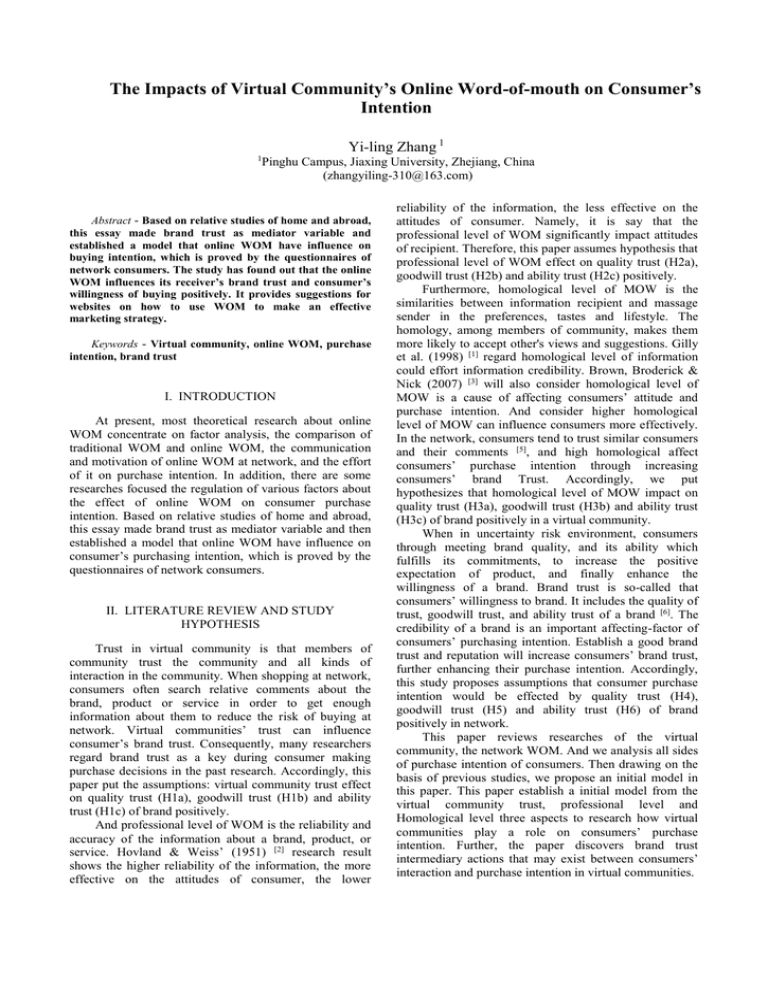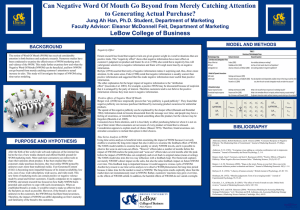reliability of the information, the ... - attitudes of consumer. Namely, it ...
advertisement

The Impacts of Virtual Community’s Online Word-of-mouth on Consumer’s Intention Yi-ling Zhang 1 1 Pinghu Campus, Jiaxing University, Zhejiang, China (zhangyiling-310@163.com) Abstract - Based on relative studies of home and abroad, this essay made brand trust as mediator variable and established a model that online WOM have influence on buying intention, which is proved by the questionnaires of network consumers. The study has found out that the online WOM influences its receiver’s brand trust and consumer’s willingness of buying positively. It provides suggestions for websites on how to use WOM to make an effective marketing strategy. Keywords - Virtual community, online WOM, purchase intention, brand trust I. INTRODUCTION At present, most theoretical research about online WOM concentrate on factor analysis, the comparison of traditional WOM and online WOM, the communication and motivation of online WOM at network, and the effort of it on purchase intention. In addition, there are some researches focused the regulation of various factors about the effect of online WOM on consumer purchase intention. Based on relative studies of home and abroad, this essay made brand trust as mediator variable and then established a model that online WOM have influence on consumer’s purchasing intention, which is proved by the questionnaires of network consumers. II. LITERATURE REVIEW AND STUDY HYPOTHESIS Trust in virtual community is that members of community trust the community and all kinds of interaction in the community. When shopping at network, consumers often search relative comments about the brand, product or service in order to get enough information about them to reduce the risk of buying at network. Virtual communities’ trust can influence consumer’s brand trust. Consequently, many researchers regard brand trust as a key during consumer making purchase decisions in the past research. Accordingly, this paper put the assumptions: virtual community trust effect on quality trust (H1a), goodwill trust (H1b) and ability trust (H1c) of brand positively. And professional level of WOM is the reliability and accuracy of the information about a brand, product, or service. Hovland & Weiss’ (1951) [2] research result shows the higher reliability of the information, the more effective on the attitudes of consumer, the lower reliability of the information, the less effective on the attitudes of consumer. Namely, it is say that the professional level of WOM significantly impact attitudes of recipient. Therefore, this paper assumes hypothesis that professional level of WOM effect on quality trust (H2a), goodwill trust (H2b) and ability trust (H2c) positively. Furthermore, homological level of MOW is the similarities between information recipient and massage sender in the preferences, tastes and lifestyle. The homology, among members of community, makes them more likely to accept other's views and suggestions. Gilly et al. (1998) [1] regard homological level of information could effort information credibility. Brown, Broderick & Nick (2007) [3] will also consider homological level of MOW is a cause of affecting consumers’ attitude and purchase intention. And consider higher homological level of MOW can influence consumers more effectively. In the network, consumers tend to trust similar consumers and their comments [5], and high homological affect consumers’ purchase intention through increasing consumers’ brand Trust. Accordingly, we put hypothesizes that homological level of MOW impact on quality trust (H3a), goodwill trust (H3b) and ability trust (H3c) of brand positively in a virtual community. When in uncertainty risk environment, consumers through meeting brand quality, and its ability which fulfills its commitments, to increase the positive expectation of product, and finally enhance the willingness of a brand. Brand trust is so-called that consumers’ willingness to brand. It includes the quality of trust, goodwill trust, and ability trust of a brand [6]. The credibility of a brand is an important affecting-factor of consumers’ purchasing intention. Establish a good brand trust and reputation will increase consumers’ brand trust, further enhancing their purchase intention. Accordingly, this study proposes assumptions that consumer purchase intention would be effected by quality trust (H4), goodwill trust (H5) and ability trust (H6) of brand positively in network. This paper reviews researches of the virtual community, the network WOM. And we analysis all sides of purchase intention of consumers. Then drawing on the basis of previous studies, we propose an initial model in this paper. This paper establish a initial model from the virtual community trust, professional level and Homological level three aspects to research how virtual communities play a role on consumers’ purchase intention. Further, the paper discovers brand trust intermediary actions that may exist between consumers’ interaction and purchase intention in virtual communities. IV. ANALYSIS AND RESULTS There were two parts of our analysis. Firstly, we use factor analysis and Cronbach’s ɑ to test reliability and validity of the model. By the purification of the measuring item, analysis the survey date using SPSS13.0; the results are as follows in table 2. TABLE II Fig. 1. RESEARCH VARIABLES ANERAGE, RELIABILITY CONEFFICIENT, AND CORRELATION CONEFFICIENT Research model 1 Variables TABLE I 1 SOURCES OF SCALES Reliability Coefficients Variables Original source 1.Virtual Community Trust 2.Homological 3.Level Professional Level Zeitham, Berry & Parasuraman [7] Bansal & Voyer [8] Netemeyer & Bearden[09][10] Brown Broderick & Nick [3] Gilly et al. [1] 0.829 0.911 0.891 4.Quality Trust 5.Goodwill Trust 6.Ability Trust Denghua Yuan et al. [6] 0.863 0.841 0.846 7.Purchase Intention Monroe, Dodds & Grewal [11] Paul A. Pavlou [12][13] 2 3 4 5 0.911 III. METHODOLOGY The study of online shopping by consumers, the research goal is to investigate and analyze the virtual community word of mouth on the impact of online shopping population mechanism. Data for this study were collected through online and offline questionnaires approach to validate the model. Investigate lasted 4 months, 458 returned valid questionnaires were initially screened for usability and reliability from 630 responses, the percentage is 72.6%. In order to ensure the reliability and validity of questionnaires, this study refers to the relevant literature and on the basis of the scale used by domestic and foreign scholars, adding, considers with the development of virtual communities’ WOM to modify scales to fit the context of online WOM. The references and sources of each variable in the scales for the questionnaire were provided in Table 1. To make sure the effectiveness of independent variables, mediating variables and outcome variables, the questionnaire was formed in three steps: first, the existing scales translation; second, expert advice collection and investigation; third, sample-validation. This test respondent was asked to indicate agreement with each statement in a measure using a 5-point scale Likentype scale. The questionnaire consists of two parts: the first part is the description of consumers’ individual characteristics with 10 questions, and the second part is to measure variables within the first research model, with 33 questions in total. 6 7 M 3.8 20 3.7 51 3.6 84 4.0 03 3.9 98 4.0 09 3.8 58 SD 0.8 72 0.8 75 0.8 64 0.8 79 0.8 63 0.8 57 0.8 59 1 2 3 4 5 6 1 0.15 6** 0.15 1** 0.36 6** 0.40 5** 0.39 1** 0.33 5** 1 0.28 6** 0.28 4** 0.16 8* 0.21 3** 0.06 0** 1 0.27 3** 0.22 7** 0.04 5* 0.05 0** 1 0.55 8** 0.46 3** 0.36 6** 1 0.54 8** 0.18 3** 1 0.29 7** p*<0.05,p**<0.01,p***<0.001 Secondly, the study used SEM to test the causal structure of the proposed research model. The causal structure of the research model (Fig.1) was tested using SEM. 458 samples of data from respondents were analyzed using Amos 5.0 to test the SEM. The goodnessof-fit indices for this model were shown in Table 3 and the test demonstrated reasonable fit between the data and the proposed structure model. The results showed that not all of the parameters were significant. TABLE II FIT MEASURES FOR SEM Fit Indicators χ /df 2 Criteria <5(Wheaton et al,1977) Results [15] 3.28 GFI ≥0.85(Bentler,1992) 0.902 AGFI ≥0.85(Bentler,1992) 0.870 IFI ≥0.9(Bentler,1992) 0.916 CFI ≥0.9(Bentler,1992) 0.915 RMSEA <0.1 (Steiger,1990) 0.065 Χ2/df is 1.845, this indicator fit for the statistical requirements. RMSEA is 0.043, according to Steiger’s opinion [14], if the RMSEA is less than 0.1 indicated good fit, lower than 0.05 indicated very good fit, and lower than 0.01 indicated very beautiful fit, so this indicator fit for the statistical requirements, too. In addition, according to Bentler’s advice [4], when the CFI ≥ 0.90, it's a great matching model as long as the GFI ≥ 0.85.Therefore, the result of the theoretical model has a very good fit (Fig.2). consumers’ attitude to optimize the next round of product design and development. REFERENCES [1] [2] Fig. 2. Research model 2 [3] V. CONCLUSION AND IMPLICATIONS To figure out the validation degree and comparison of the research model with SEM. At the same time, removing two non-significant path (professional level of WOM——>goodwill trust, homological level of WOM— —> ability trust). Finally, we got the optimal model (Fig.2). Our work generated the following research suggestions: (1) Establish brand communities to create a good community environment. Virtual communities should develop professionally, enhance the reputation in their own field and build authoritative position. Additionally, improving the community system to provide consumers with convenient, fast and reliable communication platform in the virtual communities in order that, consumers can be more effectively interact and communicate with each other and companies. In a good environment, consumers can trust each other; thereby they also trust others’ comment about product, brand or service; finally, they can reduce the risk of shopping at the network through others’ comment; and WOM also can further enhance the consumers’ brand trust. (2) Virtual community exclusion. When companies build brand virtual or brand community Union, they should pay attach to community exclusion, that is to say, the brand community should face to target consumer group. On the one hand, the consumers, who have similar values, lifestyles, hobbies and so on, can easy to get a common topic in communication. And compared with non-similar ones, consumers tend to interact with similar consumers and also incline to trust their comments. On the other hand, enterprises can take advantage of the exclusive community to provide particular service for consumers to improve their satisfaction, loyalty, and brand reputation. (3) Improve professional level of WOM. Companies can dig the more professional groups in virtual communities, and encourage or stimulate them to recommend products. When spreading the positive WOM about products to maximize the effect of publicity online. Companies also can culture the opinion leaders, not only to provide other consumers some reliable information on products, brands or services; but also to feedback other [4] [5] [6] [7] [8] [9] [10] [11] [12] [13] [14] [15] M.C. Gilly , J.L. Graham, M.F. Wolfinbarger, and L.J. Yale, “A Dyadic Study of Interpersonal Information Search” , Journal of the Academy of Marketing Science, no.2, pp.83100,1998. C.I. Hovland and W. Weiss, “The influence of source credibility on communication effectiveness”, Public Opinion Quarterly, no.15, pp.635-650,1951. J. Brown, A.J. Broderick and L. Nick, “Word of mouth communication within online communities: conceptualizing the online social network”, Journal of interactive marketing,vol.21,no.3,pp. 2-20,2007. P.M. Bentler, “Structural Equation Program Manual”, NY Press, BMDP Statistical Software, 1992. D. Smith, S. Menon and Sivakumar, “Online peer and editorial recommendations, trust, and choice in virtual markets”, Journal of interactive marketing,vol.19,no.3,pp. 15-37,2005. Denghua Yuan, Si Luo and LiYou Ming, “Structure of Brand trust and its measurement”, Psychological Exploration, pp.81-82,2007. V.A. Zeitham, L.Berry, and A. Parasuraman, “The Behavioral Consequences of Service Quality”, Journal of Marketing, vol.60,pp.31-46,1996. H.S. Bansal, and P.A. Voyer, “Word of mouth processes within a services purchase decision context”, Journal of service research,vol.3,no.2, pp.166-177,2000. R.G. Netemeyer, and W.O.A. Bearden, “A Comparative Analysis of Two Models of Behavioral Intention”, Journal of the Academy of Marketing Science ,vol.20,no.3, pp.4959,1992. S. Balasubramanian, P. Konana and N.M. Menon, “Customer Satisfaction in Virtual Environments: A Study of Online Investing”, Management Science, vol.49, no.7, pp.871-889,2003. B.M. Kent, B.D. William, and D. Grewal, “Effects of price, brand, and store information on buyers' product evaluations”, Journal of Marketing Research, vol.28,no.8, pp.307 -319,1991. P.A. Pavlou, “Consumer acceptance of electronic commerce-integrating trust and risk with the technology acceptance model”, International Journal of Electronic Commerce,vol.7,no.3, pp.69-103,2003. L. G. Schiffman and L. C. Kanuk, “Consumer behavior”. Wisconsin: Prentice Hall International,2000. J.H. Steiger, “Structural model evaluation and modification: an interval estimation approach”, Multivariate Behavioral Research, vol.25, pp.173-180,1990. B. Wheaton, D. Muthen, D. Alwin, ,and G. Summers, “Assessing reliability and stability”, Panel Models Sociological Methodology, 1977.



